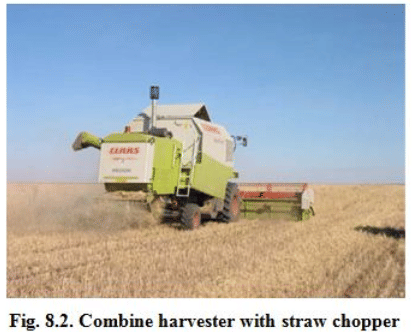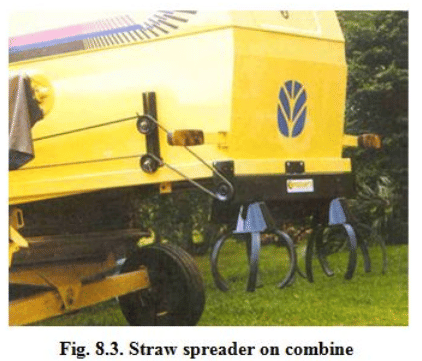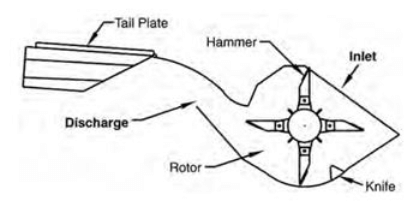Paddy Straw choppers and spreaders as an attachment to combine Harvester | Biomass Management for Fodder & Energy - Agricultural Engineering PDF Download
Introduction
The combine harvester or simply combine is a machine that harvests grain crops.
The function of a combine harvester is to cut, thresh, winnow and clean grain/seed. Most Combine harvesters consist of several major components: the cutting section, the thresher, devices for separating the straw, a cleaner and a grain collection system.
The cutting section usually consists of straw lifters especially for lifting lodged crop, a cutter bar for cutting the straw above the ground, a reel for feeding the cut crop into the conveying system and conveyors for transporting the crop to the threshing components.
The thresher consists of one or more threshing cylinders and a concave. The threshing unit can be conventional but in most cases rice combines have axial-flow threshing and straw separation units, which are better in handling wet straw and do not require straw walkers for separating the straw. Other advantages of the axial flow concept are higher throughput and gentler treatment of fragile seeds like Basmati, which are often cracked by the faster rotational speeds of conventional combine threshing cylinders.
A conventional combine has a set of straw walkers for separation of the grain from the straw because the crop passes the concave very quickly and a lot of threshed grains are therefore still contained in the straw. On the straw walkers the remaining grains are separated from the straw by gravity.
All combines contain a cleaner in which chaff, immature grains and small straw particles are separated form the grains. The cleaner consists of a blower and several oscillating sieves. For grain collection the combine either has a grain tank or is equipped with a grain bagging station. For transporting the grain and other fractions inside the combine and for unloading the grain tank there are several conveyors, which can be bucket elevators or screw conveyors.

8.2. Classification
8.2.1. Self-Propelled Combine
A combine on which an engine of suitable power rating is mounted to serve as a source of power is called self-propelled combine. This may be wheeled type or track-laying type.
In wheel combine pneumatic wheels are used. Track-laying type combine fitted with full or half tracks instead of pneumatic wheels.
8.2.2. Tractor-Operated Combine
Tractor operated combine requires a tractor of suitable power rating to serve as a source of power for its working. It may be trailed type or side-mounted type.
8.3. Combine harvester with straw chopper
If the straw to be incorporated into the soil a straw chopper and attachment is used in combines. In many cases modern combines are equipped with straw-choppers. The chopper catches the straw falling from the straw walker and cuts this with high-speed rotating knives. For a good mulching of straw in the soil, the chopped straw is intentionally frayed and split by the design of the chopper hood. The straw chopper must be set in a way that all the straw and chaff is spread uniformly across the cutting width of the combine. The straw and the chaff should be redistributed over the whole cutting width by rotating distributors. Sheet metal shields are able to compensate for crosswinds.

8.4. Combine harvester with straw spreader
Under Conservation Agriculture it is preferable even in the case of cereal straw not to chop but just to spread the straw behind the combine harvester. This saves energy and fuel, provides a longer lasting soil cover and reduces the danger of hair pinning – straw being push into the seed slot during planting. Straw spreaders for combine harvesters are commercially available.

8.5. Combine with choppers and spreaders
In Combine with choppers and spreaders the straw falls directly into the chopper. Chaff is fed into the chopper by either a conveyor or a reciprocating chaff conveying pan. The unique design of the hammers enables the chopper to also act as a fan. Air and light chaff are drawn into the front of the chopper. The hammers pull in the straw and heavy chaff. The mechanical force of the hammers combines with the air to discharge the material. As material exits the chopper, the tail plate and the cupped vanes control the spread width and uniformity.

Chaff and straw spreading is a key part of good soil management. Heavy concentration or rows of chaff and/or straw can cause difficulty in subsequent tillage and seeding operations. Heavy concentrations may also cause slow soil warming, nitrogen depletion or toxic buildup. Ideally, all crop residues should be redistributed evenly over the field. This seldom happens. To get the most effective spread, it is necessary to match cutting and spreading widths closely. It is important that the spreader provide suitable spread uniformity over the spread width.
All combine choppers and spreaders are potentially dangerous. Material discharged can reach velocities that can cause serious injury or death. Extreme caution is required at all times when working near operating choppers or spreaders. It is especially important when working near choppers that discharge closer to head height.
FAQs on Paddy Straw choppers and spreaders as an attachment to combine Harvester - Biomass Management for Fodder & Energy - Agricultural Engineering
| 1. What is a paddy straw chopper and spreader? |  |
| 2. How does a paddy straw chopper and spreader work? |  |
| 3. What are the benefits of using a paddy straw chopper and spreader? |  |
| 4. Can a paddy straw chopper and spreader be used with any type of combine harvester? |  |
| 5. How can I maintain and care for a paddy straw chopper and spreader attachment? |  |















